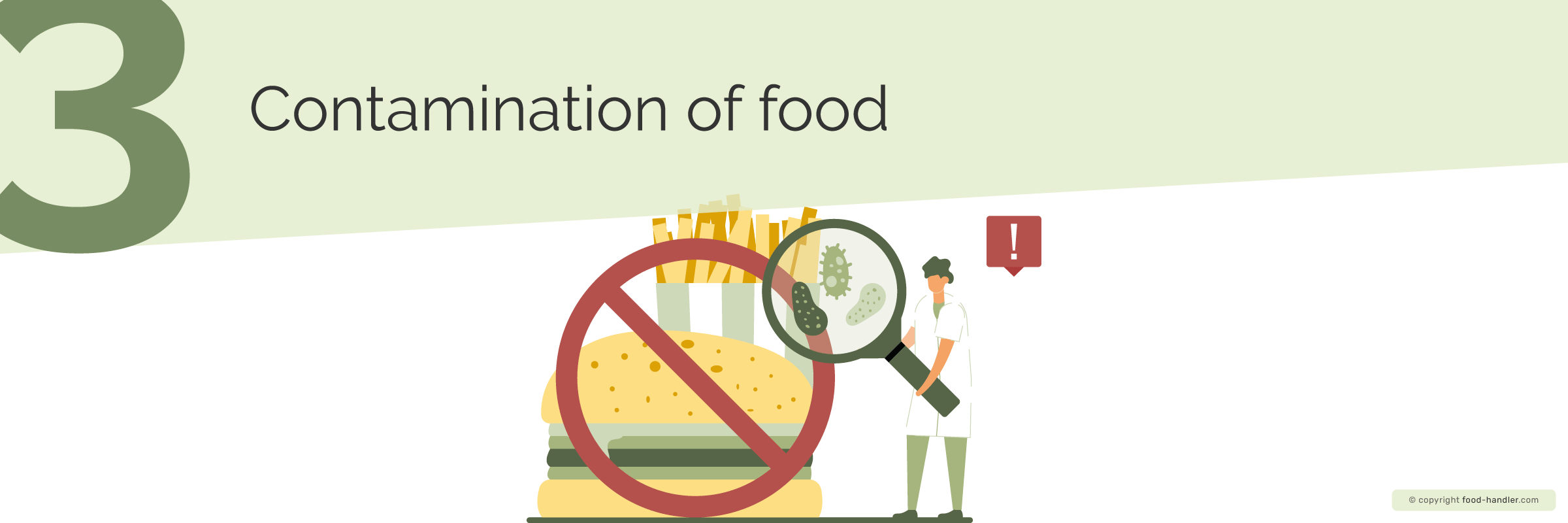FOOD HYGIENE AND SAFETY - LEVEL 2 COMPLIANT - CERTIFICATION


Updated on 2024
Lesson 3: summary

FOOD CONTAMINATION. TYPES OF CONTAMINANTS AND HAZARDS.
What is food contamination? A contaminant or a food hazard is any foreign agent to the food that is capable of producing a negative effect on the health of the consumer.
According to their origin the hazards are classified into:
The main food contamination sources are:
Lesson 3: extended
A contaminated food is any food that contains any agent foreign to the food itself that may be harmful to the health of the consumer.
Depending on the origin of the contaminant, the types of food contamination are classified into physical, chemical and biological.
They are foreign objects that are generally appreciated by the human eye, such as crystals, pellets, bones, thorns, shells, plastics, personal effects (earrings, watches, pendants...)... all of them pose a danger to the consumer since they can cause damage such as cuts, choking, etc...
In this group we include toxic substances that can reach the food by chance, or that are present in it due to incorrect handling. They are chemical products of all kinds such as: cleaning and disinfection products, insecticides, air fresheners, pesticide residues, heavy metals...
It is caused by the action of living beings that contaminate food. A biological contaminant of food can be any living being such as: insects (flies, cockroaches...), rodents (rats and mice), birds (pigeons, sparrows, seagulls...), parasites (worms, weevils...), or microorganisms (bacteria, viruses and molds).
It is the passing of contaminants from one food to another. It can be produced by mixing raw and cooked foods (in cooked foods we have eliminated most of the bacteria but not in raw foods, and they can pass from one to another, making cooked foods dangerous to health). Cross contamination can also occur when using the same utensils (cutting board, knife....) to treat raw and then cooked food without cleaning them first.
Food at its source can become contaminated or altered due to the effect of environmental toxins, agricultural pollutants or livestock products.
This is one of the most common types of food handling. The food handler is the major risk factor for food contamination because he or she is in constant contact with food. For this reason, good food handling practices should be maximized to minimize risks as much as possible. General hygiene is essential, both in the workplace, in utensils and in personal hygiene. Handler's diseases, such as colds, can also be transmitted to food by coughing or sneezing.
Contaminated food does not always show obvious signs of spoilage. In packaged foods, it is essential to accept or reject the food on the basis of the expiry date indicated on the package. If the food is out of date, the safest option is to discard it, since although it may appear to be in good condition, it may have begun its natural deterioration process.
The most obvious signs of contamination in meat are: green or brown coloration, rotten smell or slimy texture. In the case of birds, it is most common to observe a slimy film on the skin and meat, accompanied by an unpleasant smell.
Fresh fish shall have reddish eyes of the same colour and bulging, whole scales and reddish gills. Fresh fish has firm, abundant and shiny scales. When the scales are removed too easily, it is an indicator that the skin of the fish is soft and therefore not fresh. On the other hand, the fish that has lost its freshness has dark, brownish gills, sunken, opaque eyes, and detached scales in parts.
In the case of eggs, a good way to find out quickly and without having to spend time checking them is to fry them or open them in a container. If the bud is in good condition, it will remain centered in the center of the egg white and whole. A tip for when several eggs are going to be collected, such as for example to make an omelette, is to open it in a container different from the recipient, because if it is in poor condition can be discarded without throwing all the eggs that have been collected in the same container. Another very reliable, though somewhat more laborious, way is to immerse them in salt water: if they sink, that means they are fresh and ready for consumption, but if they float, it means they are in poor condition and cannot be consumed.
On the other hand, in the case of milk or other milk products such as cheese, it is easier to differentiate whether they are in poor condition or whether they are still suitable for consumption. The milk in poor condition is very evident, has a yellowish or greenish color and a sour taste that possibly, although we do not realize that it is in poor condition when served, the taste will certainly take us out of doubt and we can not consume it. Cheeses in poor condition have a green or brown colour, an unpleasant smell and a slimy layer. They may also have fungi that are not typical of a variety of cheese.
The case of contamination in fruits is also quite visible. Thus, signs of contamination present in fruits can be: fungus, pieces too soft or with a part of the piece too soft compared to the rest, presence of flies around or the fruit cover of a slimy film.
We use 256 bit SSL encryption technology to guarantee the security of our website. You are safe with us.